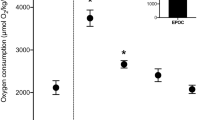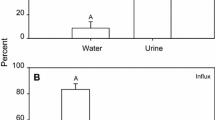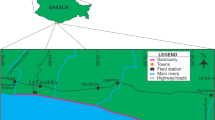Summary
Green sea turtles (Chelonia mydas) are well known as endurance swimmers and divers. Physiological correlates of these traits were studied in 9 adult sea turtles (mean body mass=87 kg) at a body temperature of 25°C. The respiratory properties of the blood were similar to those of other turtles except for a higher oxygen affinity (P 50=18.2 Torr, pH 7.6), which may be an allometric function. Resting, systemic blood flow, calculated from the Fick principle was 21.5 ml·kg−1. min−1, similar to values reported for other turtles. Pulmonary blood flow, measured by mass spectrometry of acetylene uptake in the lungs was 24.0 ml·kg−1·min−1, not significantly different from the calculated systemic flow. Other evidence of a small (net) intracardiac shunt is the high arterial saturation (ca. 90%) of arterial blood. This distinctive feature of O2 transport inC. mydas provides an\([Ca_{O_2 } - C\bar \upsilon _{O_2 } ]\) content difference of 4.1 ml· dl−1. This results in a relatively low blood convection requirement at rest\(\dot Q_t /\dot V_{O_2 }\)=24.4 mlbtps·mlstpd −1), similar to that for many mammals. This would favor a high maximum O2 uptake, as measured by others in this species. The relatively high O2 affinity of blood in this species could be adaptive to “loading” O2 during intermittent breathing while swimming and to utilizing the lung O2 store during the progressive hypoxia of diving.
Similar content being viewed by others
References
Andersen HT (1961) Physiological adaptations in diving vertebrates. Physiol Rev 46:212–243
Baker LA, White FN (1970) Redistribution of cardiac output in response to heating inIguana iguana. Comp Biochem Physiol 35:253–262
Berkson H (1966) Physiological adjustments to deep diving in the Pacific Green Turtle (Chelonia mydas agassizii). Comp Biochem Physiol 21:507–524
Bennett AF (1973) Blood physiology and oxygen transport during activity in two lizards,Varanus gouldii andSauromalus hispidus. Comp Biochem Physiol 46A:673–690
Burggren WW, Shelton G (1979) Gas exchange and transport during intermittent breathing in chelonian reptiles. J Exp Biol 82:197–213
Burggren WW, Hahn CEW, Foex P (1977a) Properties of blood oxygen transport in the turtle,Pseudemys scripta, and the tortoise,Testudo graeca: effects of temperature, CO2, and pH. Respir Physiol 31:39–50
Burggren WW, Glass ML, Johansen K (1977b) Pulmonary ventilation: perfusion relationships in terrestrial and aquatic chelonian reptiles. Can J Zool 55:2024–2034
Butler PJ, Jones DR (1982) The comparative physiology of diving in vertebrates. Adv Comp Physiol Biochem 8:179–364
Carr AF, Goodman D (1970) Ecological implications of size and growth in Chelonia. Copeia 1970:783–786
Carr AF, Ross P, Carr S (1974) Interesting behavior of the green turtle,Chelonia mydas, at a mid-ocean breeding ground. Copeia 1974:702–706
Crawford EC, Gatz RN, Magnussen H, Perry SF, Piiper J (1976) Lung volumes, pulmonary blood flow, and carbon monoxide diffusing capacity of turtles. J Comp Physiol 107:169–178
Dejours P, Garey WF, Rahn H (1970) Comparison of ventilatory and circulatory flow rates between animals in various physiological conditions. Respir Physiol 9:108–117
Ekblom B, Goldberg AO, Gullbring B (1972) Response to exercise after blood loss and re-infusion. J Appl Physiol 33:175–180
Gatz RN, Johansen K (1978) Gas exchange and pulmonary blood flow during diving in the Nile crocodile and caiman. Trans Kansas Acad Sci 81:92–93
Glass ML, Johansen K, Abe AS (1981) Pulmonary diffusing capacity in reptiles (relations to temperature and O2 uptake). J Comp Physiol 142:509–514
Glass ML, Boutelier RG, Heisler N (1983) Ventilatory control of arterial\(P_{O_2 }\) in the turtle,Chrysemys picta bellii: effects of temperature and hypoxia. J Comp Physiol 151:145–153
Gleeson TT, Mitchell GS, Bennett AF (1980) Cardiovascular responses to graded activity in the lizardsVaranus andIguana. Am J Physiol 239:R174-R179
Haab PE, Piiper J, Rahn H (1960) Simple method for rapid determinations of an O2 dissociation curve of the blood. J Appl Physiol 15:1148–1149
Heisler N, Neuman P, Maloiy GMO (1983) Mechanism of intracardiac shunting in the lizard,Varanus exanthematicus. J Exp Biol (in press)
Howell BJ, Rahn H (1976) Regulation of acid-base balance in reptiles. In: Gans C, Dawson WR (eds) Biology of the reptilia, Physiology A. Academic Press, New York, pp 353–364
Jackson DC, Prange HD (1979) Ventilation and gas exchange during rest and exercise in adult green sea turtles. J Comp Physiol 134:315–319
Kooyman GL (1973) Respiratory adaptations in marine mammals. Am Zool 13:457–488
Landis AT Jr (1965) New high pressure research animal. Undersea Technol 6:12
Lapennas GN, Lutz PL (1982) Oxygen affinity of sea turtle blood. Respir Physiol 48:75–87
Lenfant C, Johansen K, Torrance JD (1970a) Gas transport and oxygen storage capacity in some pinnipeds and the sea otter. Respir Physiol 9:277–286
Lenfant C, Johansen K, Petersen JA, Schmidt-Nielsen K (1970b) Respiration in the fresh water turtle,Chelys fimbriata. Respir Physiol 8:261–275
Millen J, Murdaugh E, Victor H Jr, Bauer CB, Robin ED (1964) Circulatory adaptations to diving in the fresh water turtle. Science 145:581–593
Perry SF, Dunker HR (1978) Lung structure, volume, and static mechanics in five species of lizards. Respir Physiol 34:61–81
Prange HD, Jackson DC (1976) Ventilation, gas exchange, and metabolic scaling of a sea turtle. Respir Physiol 27:369–377
Rahn H, Garey WF (1973) Arterial CO2, O2, pH, and HCO −3 values of ectotherms living in the Amazon. Am J Physiol 225:735–738
Reeves RB (1976) Temperature-induced changes in blood acidbase status: pH and PCO2 in a binary buffer. J Appl Physiol 40:752–761
Rossoff L, Zeldin R, Hew E, Aberman A (1980) Changes in bloodP 50: effects on oxygen delivery when arterial hypoxemia is due to shunting. Chest 77:142–146
Schall JJ, Bennett AF, Putnam RW (1982) Lizards infected with malaria: Physiological and behavioral consequences. Science 217:1057–1058
Southworth FC, Redfield AC (1926) The transport of gas by the blood of the turtle. J Gen Physiol 9:387–403
Steggerda FR, Essex HE (1967) Circulation and blood pressure in the great vessels and heart of the turtle. Am J Physiol 190:320–326
Tenney SM, Tenney JB (1970) Quantitative morphology of cold-blooded lungs: Amphibia and Reptilia. Respir Physiol 9:197–215
Tenney SM, Bartlett D Jr, Farber JP, Remmers JE (1974) Mechanics of the respiratory cycle in the green turtle (Chelonia mydas), Respir Physiol 22:361–368
Thorson TB (1968) Body fluid partitioning in Reptilia. Copeia 68:592–601
Tucker VA (1966) Oxygen transport by the circulatory system of the green iguana (Iguana iguana) at different body temperatures. J Exp Biol 44:77–92
White FN (1976) Circulation. In: Gans C, Dawson WR (eds) Biology of the reptilia, vol 5. Academic Press, New York, pp 275–334
White FN (1978) Circulation: a comparison of mammals, reptiles, and birds. In: Piiper J (eds) Respiratory function in birds, adult and embryonic. Springer, Berlin Heidelberg New York, pp 51–60
White FN, Kinney J (1976) Ventilation-perfusion relationships in the turtle (Abstract). Physiologist 19:409
Wilson JW (1939) Some physiological properties of reptilian blood. J Cell Comp Physiol 13:315–326
Wood SC (1982) The effect of oxygen affinity on arterial PO2 in animals with vascular shunts. J Appl Physiol 53:1360–1364
Wood SC, Johansen K (1974) Respiratory adaptations to diving in the Nile monitor lizard. J Comp Physiol 89:145–158
Wood SC, Lenfant C (1976) Respiration: mechanics, control, and gas exchange. In: Gans C, Dawson WR (eds) Biology of the reptilia, vol 5. Academic Press, New York, pp 225–274
Wood SC, Johansen K, Gatz RN (1977) Pulmonary blood flow, ventilation/perfusion ratios, and oxygen transport in a monitor lizard. Am J Physiol 233:R89–93
Wood SC, Lykkeboe G, Johansen K, Weber RE (1978) Temperature acclimation in the pancake tortoise: Metabolic rate, blood pH, oxygen affinity, and red cell organic phosphates. Comp Biochem Physiol 59A:155–160
Author information
Authors and Affiliations
Rights and permissions
About this article
Cite this article
Wood, S.C., Gatz, R.N. & Glass, M.L. Oxygen transport in the green sea turtle. J Comp Physiol B 154, 275–280 (1984). https://doi.org/10.1007/BF02464407
Accepted:
Issue Date:
DOI: https://doi.org/10.1007/BF02464407




